You are currently browsing the multiverse talk category
So I was looking up some pricing info on one of those “Hot Comics Apps,” as I occasionally have to do out of self-defense, when I came across this note on the 2008 Justice Society of America Annual:

And here is said Old Joker of this newer version of Earth-2, as he appears courtesy Geoff Johns, Jerry Ordway and Bob Wiacek:
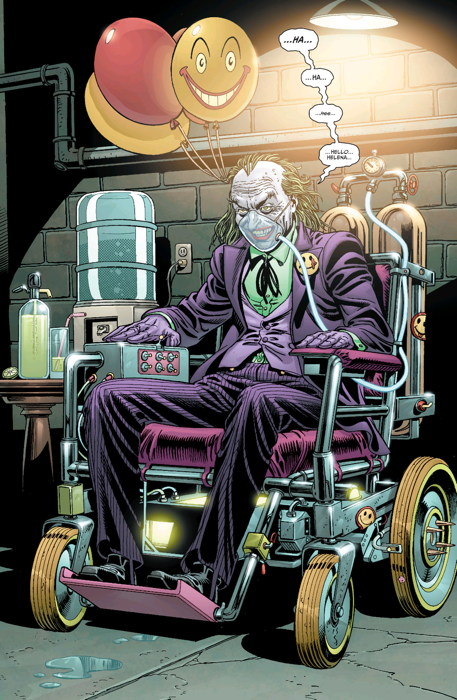
SMILE FOR YOUR CLOSE-UP
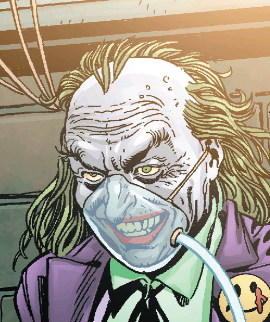
Anyhoo, seeing that particular notation in the app made me say “Whoa, hold on, I know that ain’t true.” Yes, I totally said that out loud in the shop, how dare you doubt me. But the first thing I thought of after seeing it was Brave and the Bold #200 from July 1983, in which we also see an Old Joker, also from Earth-2 (the real one, not the “make Crisis on Infinite Earths never not so” version we got post…Infinite Crisis?). Here he is, via the talents of Mike W. Barr and Dave Gibbons:
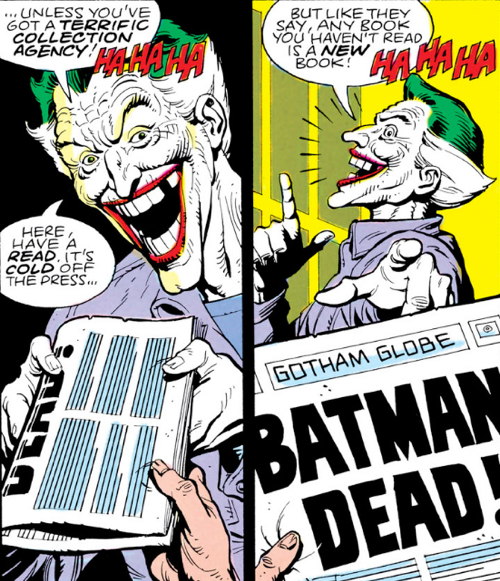
All I can say is this Earth-2 version of the Joker aged a lot in two years, as in August 1981’s Wonder Woman #281 through #283, the Huntress back-up stories by Paul Levitz, Joe Staton and Steve Mitchell feature…you guessed it, the Earth-2 Joker, looking as hale and hearty as he ever did:
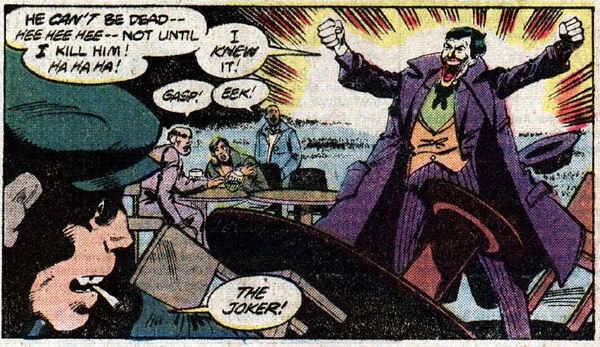
Now, trying to pin down exact ages for comic book characters can be tricky, but it’s my assumption that the Earth-2 characters, at least the ones introduced in the actual real-life Golden Age, more or less aged in real time (and yes, I know Roy Thomas retconned a little “energy boost” for all o’them in All-Star Squadron Annual…#2, wasn’t it?) which let us have 90-or-more-year-old JSAers runnin’ around well into the 2000s.
As such, assuming the Earth-2 Batman appeared in the fictional universe at the same time as in the real world, 1939, and a presumption that the Joker would be of a similar age, theoretically Joker could be somewhere around 70 years old in that Brave and the Bold issue. Kind of a rough seventy, to be honest, but being a super-villain probably isn’t the easiest of lifestyles, what with getting punched in the face all the time by the good guys.
I don’t think the B&B200 appearance necessarily contradicts his still relatively-youthful looks in those Huntress stories from a couple of years earlier. If he’d been in hiding and out of the clutches of the law, as per that storyline’s premise, and given the Joker’s own vanity, he probably had plenty of opportunity to wash that grey right out of his hair, apply the wrinkle cream, do his nails (I mean, honestly, look at the nails in those B&B panels), that sort of thing. You know, stuff he wouldn’t be allowed to do, most likely, during his 1983 imprisonment.
For comparison, here’s Old Joker from issue two of John Byrne’s alternate history series Superman/Batman: Generations II #2 (2001):
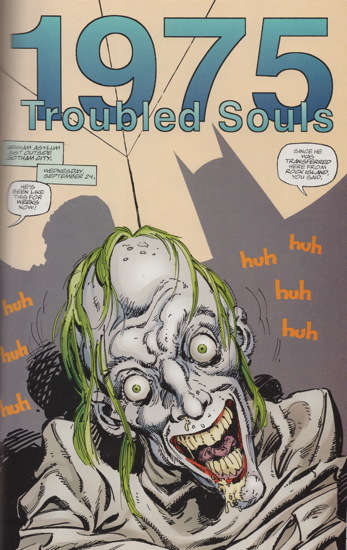
Looking a little more rough around the edges that the other versions shown here, I think. It appears this Byrne continuity starts about ten years earlier than the traditional Earth-2 superhero universe, which would put this Joker in 1975 at about the same age as our Joker appearances in Brave and the Bold and the Huntress stories.
I know, I know, all this talk about the Joker’s supposed age. I’d assumed he’s around Batman’s age, but honestly, who knows. That Joker movie would have him at, what, a couple of decades older at least? Anyway, the actual age of the Joker isn’t the point of this post, so much as “take information on Hot Comics Apps with a grain of salt” because, as shown here, they ain’t always right. And I’m sure these aren’t the only examples of Old Jokers predating that Justice Society Annual to boot.
Special thanks to the Crown Prince of Cookies, Bully the Little Stuffed Bull, for production assistance.
Back to your multiversal comments!
Buck Ripsnort gallops in with
“I think what blew the Multiverse out of my mind was the origin of Powergirl. Instead of making her a new character, or even just Earth-2’s Supergirl, they made her into something so convoluted that my mind refuses to recall it.”
When it was just Earth-1 and Earth-2 and such, Power Girl’s deal was a lot simpler. She’s the cousin of Earth-2 Superman. That’s it, done deal. But then that pesky Crisis on Infinite Earths happened along and all that Earth-2 business was flushed away, so now what?
I gotta be honest, most of my Power Girl reading from anywhere close to that time was when she was in…Justice League Europe, I’m going to say? But I do know they tried to tie her in somehow to Arion, Lord of Atlantis, but I’m unfamiliar with any of that nonsense and I think it was undone relatively quickly anyway. As it stands now she’s once again from Earth-2 (not the same Earth-2 as the Pre-Crisis Earth-2, but a new Earth-2) and, well, that’s where we stand now. I suppose I could Wikipedia it and see what the official deal is, but frankly I already have a headache, and

…no, I said I wasn’t going to go look at Wikipedia. And that’s final.

AUGH okay, fine, I’ll go look.
…
So here’s what the ol’ Wiki, right and true in all things, has to say:
“Power Girl’s origin has gone through revisions, but over time has reverted to her original conception as the Supergirl of Earth-Two. The 1985 limited series Crisis on Infinite Earths eliminated Earth-Two from history, causing her to be retconned as the granddaughter of an Atlantean sorcerer known as Arion. This was an unpopular change and writers depicted the revised Power Girl inconsistently. The 2005–2006 Infinite Crisis limited series then restored her status as a refugee from the Krypton of the destroyed Pre-Crisis Earth-Two universe. Following DC’s 2011 ‘Flashpoint’ storyline and New 52 reboot, Power Girl’s origin was retold as the Supergirl of ‘Earth 2,’ cousin and adopted daughter of Superman, who during evil Fourth World New God Darkseid’s invasion of Earth 2 becomes stranded in the main continuity of Earth 0, subsequently adopting the name Power Girl to hide her true identity. She returned to her source Earth in the story Earth 2: World’s End (2014–2015).”
So there you go. About as clear as we can manage, I think. Though in one of the animated series some years back Power Girl was just a clone of Supergirl, kinda sorta. It’s a little amusing that the origin is “she’s from Earth-2,” and has more or less remained that way even as what “Earth-2” means in DC continuity changes.
• • •
CP Bananas’s
comment has appeal
“I remember that the thing I most missed in the post-Crisis DC universe was the idea (prevalent in the late ’70s, I believe) that, on both Earth-1 and Earth-2 (maybe more?) Superman was the first superhero. It made him special in-universe and mirrored his role in the real world. One debuted in 1938, the other in some indeterminate recent–ish year. I just kept expecting them, once that year got too far back, to roll the odometer over into a new earth. Still makes sense to me.”
I always like that particular conceit, even if, as I’m about to go into, Superman’s status as “the first dude” may not strictly be true.
This panel is probably my favorite statement on the matter, coming from the way great 1981 JLA/JSA crossover by Gerry Conway and George Perez:

But the thing that always comes to mind is “aren’t…aren’t there other heroes that popped up before him,” like Miss Liberty, active during the Revolutionary War; the 15th-century Super-Chief; and depending on who you ask, sometimes the Crimson Avenger is cited as being first out the door; and I’m sure there are others I’m missing, too. Oh, like Immortal Man. Or the Shining Knight. Do they even count?
I always worked this out in my head as “the first hero of the Modern superhero age” and that was good enough for me.
So a comic that’s sorta half-intrigued me for years (and I last mentioned here) is this one, Justice League of America #38 (1965), featuring Coming-to-Theaters-Near-You Dr. Fate giving a blonde-haired Superman a mystical knuckle sandwich:
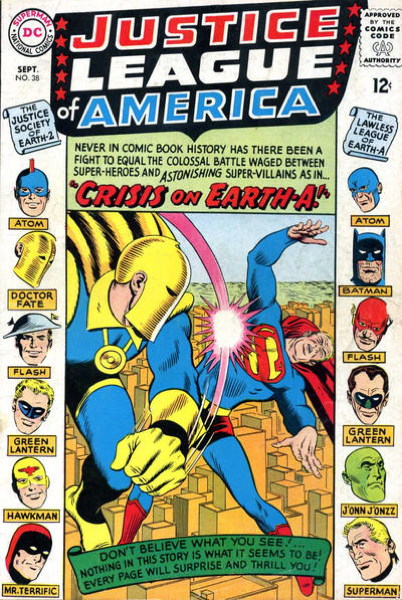
The cover mentions “Earth A,” which wasn’t one of the many parallel-universe Earths with which I was mainly familiar, and didn’t recall it ever popping up in any later multi-Earth adventures in those wild and carefree pre-Crisis days.
Well, this is actually a two-parter, beginning in issue #37, where Earth-2’s Johnny Thunder idly asks his magical Thunderbolt to bring him to Earh-1’s Johnny Thunder for a little meet ‘n’ greet. And as it turns out, this other Johnny is…not quite as dignified as Earth-2 Johnny:
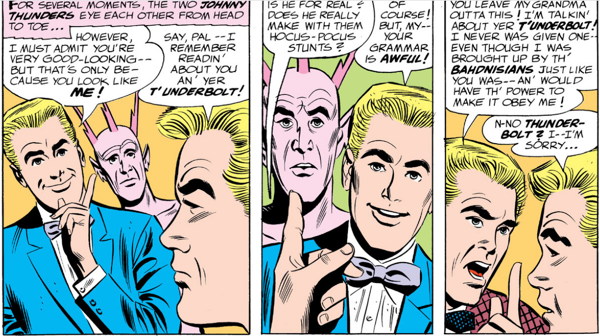
…and eventually Earth-1 Johnny realizes, since he’s basically the same guy as Earth-2 Johnny, he can just take over commanding the Thunderbolt, after, you know, trying to figure out what the magic word is (with some commentary from the T-bolt about his high opinion of both Johnnys):
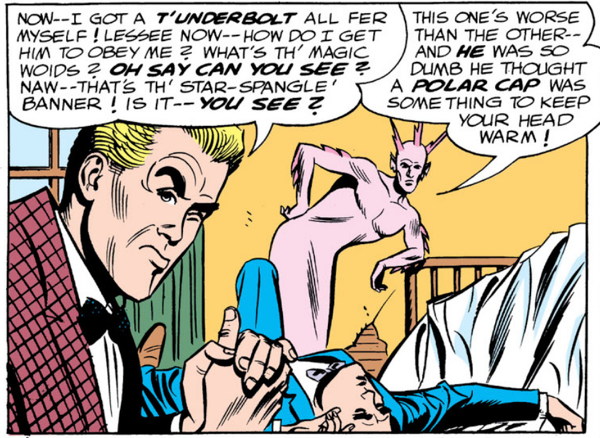
…and then he proceeds to go on his merry way to cause menace and mayhem.
Long story short (and this story is long and a tad convoluted), Johnny’s Evil Twin Johnny decides that his attempted crime spree on Earth-1 being halted by the Justice League was a pain, so he commanded the thunderbolt to go back in time and prevent all the Justice Leaguers from ever becoming superheroes. Like so:
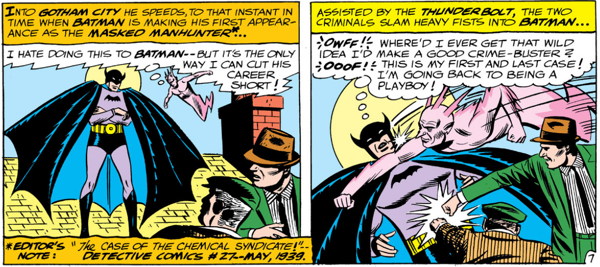
Eventually, the Thunderbolt’s sad tasks are completed, some off-panel:
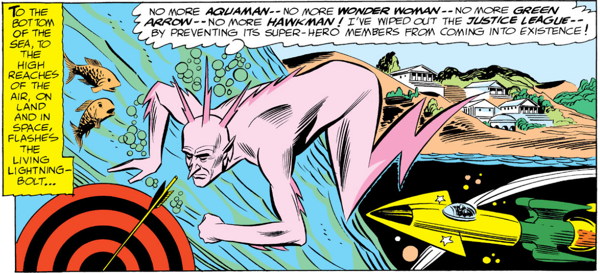
As a result, we get a modern Earth with a changed history in which the Justice League never existed and I’m going to guess never got in the way of Evil Johnny’s crime plans in the first place thus never requiring him to send the Thunderbolt back in time…but anyway, comic book magic, everyone! Regardless of any implicit paradoxes, Evil Johnny dubs the resultant Earth-1 as “Earth-A,” with A standing for…
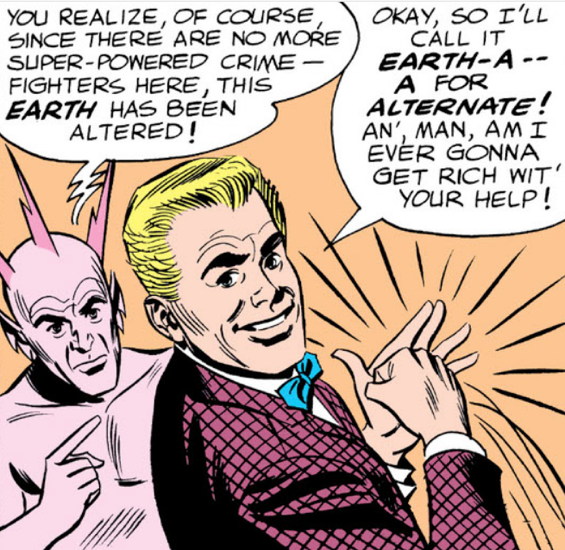
So, as Brad noted in his comment last week with NO SPOILER WARNING WHATSOEVER for this 60-year-old comical book, this ain’t your garden-variety parallel Earth as suggested by the familiar nomenclature. It’s just Earth-1 with a magical coat of paint slapped on it, which addresses my previous wonderings as to why it was never revisited in future multi-Earth events at DC. I mean, one could make the argument that an alternate timeline by its very nature creates a parallel reality, and some might even exclaim “Hypertime!” before they’re escorted out of the auditorium, but things are already complicated enough, I think.
So now that mystery is solved for yours truly, the fella what never read this story prior to this past week. But still remains the question: what’s up with that blonde Superman and the rest of that scraggly new JLA?
Well, as it turns out, Earth-2’s Justice Society eventually twigs onto what’s going on, since this is, after all, one of the annual team-ups between Earths 1 and 2. To protect himself, Evil Johnny commands the T-bolt to take some of his gang of thugs, go back in time, and insert them into the moments in which they would have their “origins” or otherwise get their powers. Look, see, here’s Thundie taking off to do the deed right now:
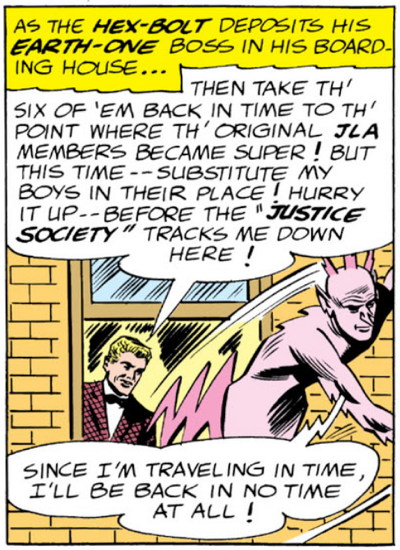
For example, we see one of the gang take the place of Ray Palmer in his origin as the Atom:
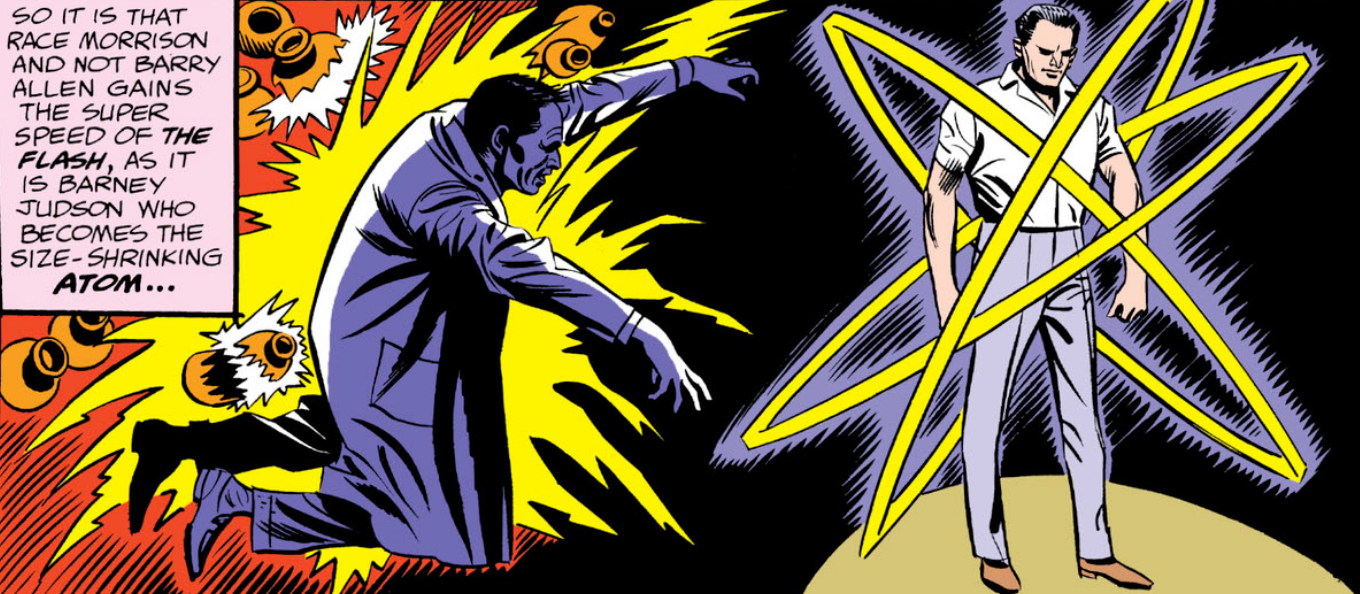
…and I hope you enjoyed that example, because that’s all the book’s giving you since in the very next panel, the deed is done:
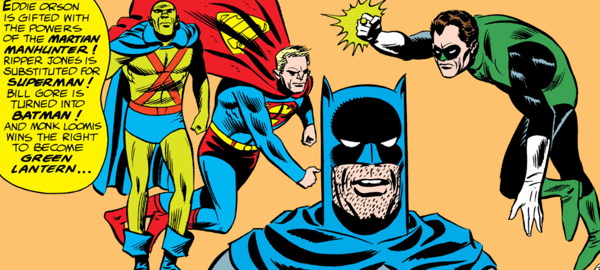
Not sure what exactly T-bolt did to get that one blonde guy to replace Superman in his origin, aside from 1) turning him into a baby, 2) putting him on Krypton, 3) literally making him Kryptonian, and 4) ensuring that Jor-El would send Ugly-El to Earth, eventually. Or else that guy was just magically given Superman’s powers. At any rate, don’t get me started on that Martian Manhunter substitute and however that worked.
Anyway, here’s another look at ’em:
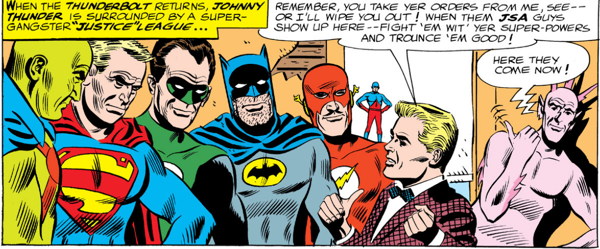
Please sign my petition to make the Flash look like this from now on:
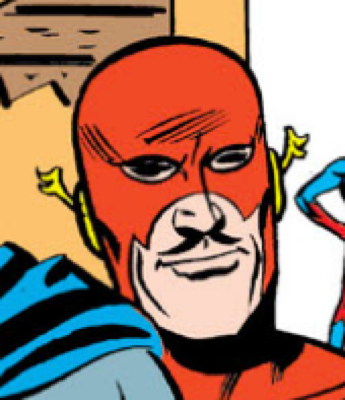
To wrap this up quickly, the Lawless League is defeated, the regular Justice League returns, Evil Johnny commands the Thunderbolt to fight Doctor Fate:
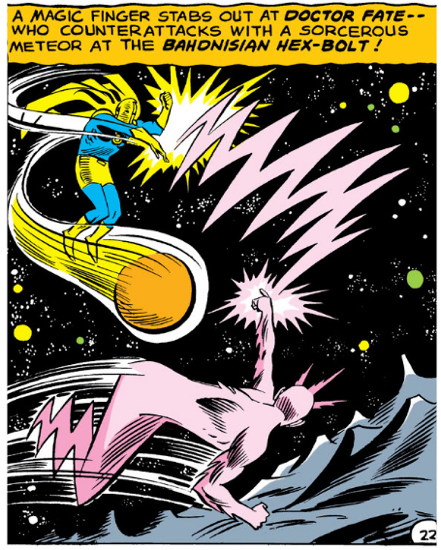
…and he’s overwhelmed by the results of this mighty battle, of which we only really see the one panel, the rest being devoted to Evil Johnny being smacked around by the terrible magic forces thus unleashed. In the end, there’s a wish that “none of this ever happened,” and one magical reset button later, the proper JLA/JSA meeting can commence.
And that’s it for the Johnny Thunder of Earth-1 until 1983, when he shows up in the next-to-last of the long-standing JLA/JSA team-up traditions. But I can always cover that later if needs warrant. And I hope they don’t because this turns into kind of a regrettable Black Canary story what we can just kind of pretend didn’t happen.
So that’s The Horrifying Secret of Earth-A, my friends. Not a parallel Earth, maybe, but close enough for our purposes here, I guess. Thanks to all your interaction and support on this recent series of posts, and I’ll be reacting to more of your comments soon…usually with outright fear.
Tim noted
“My first real introduction to alternate universes was reading the classic ‘To Kill A Legend’ in a collection I had as a lad. The idea of Batman going to another universe with the chance to save the lives of his parents BLEW MY LITTLE BOY MIND.”
The comic that story originally appeared in was Detective Comics #500, released in late 1980/early 1981 when I was about 11 years old. Here’s the great jam cover that wrapped around this extra-sized funnybook:
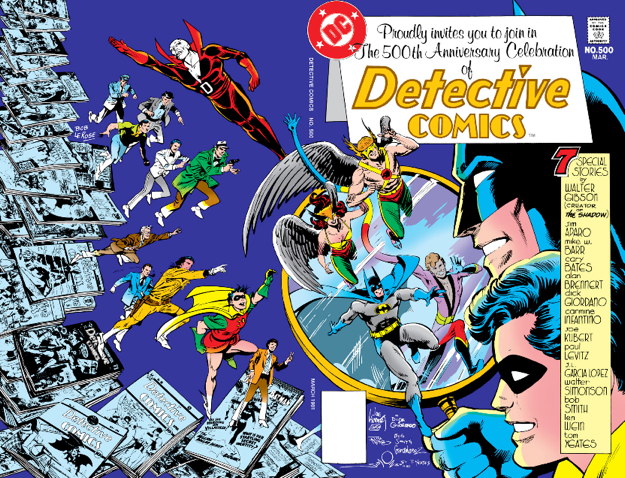
Very early on here on this site, I did a series of posts about anniversary issues, including an entry on this very issue giving an overview of all the contents.
In “To Kill A Legend” by Alan Brennert and Dick Giordano, the Phantom Stranger shows up to lay all this on the Caped Crusader:
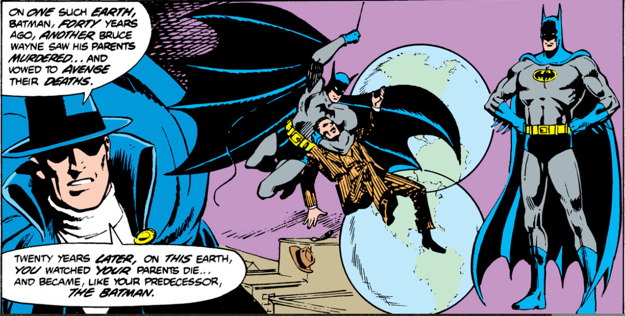

He’s obviously referring to the Earth-2 Batman as the Bruce Wayne whose parents were murdered 40 years ago (at then-press time), pictured there with an image evoking Batman’s first appearance on the cover of Detective Comics #27 back in 1939. The Bruce Wayne of “twenty years later” is Earth-1 Batman, the star of this particular show. (As an interesting side-note, assuming Bruce was somewhere between 5 to 10 years old at the time of the Waynes’ murders, that would put Earth-2 Batman at about 45-50 years old, and Earth-1 Bats at 25-30.)
The interesting implication of this story is not only that there is a new, apparently unnumbered parallel Earth in the DC Universe that may or may not have a Batman (not spoiling the story, you should read it!), but that there is a 20-year-cycle to these events duplicating in alternate universes. Going by that, we should’ve had another couple o’Batmans since then…and in a way, maybe we have, what with all the Crises and Rebirtheries, if perhaps not on a strict 20-year timeline.
It is a very good story, and one of the rare multiversal excursions in the DC Universe that doesn’t involve travel to one of the recognized Earths in the company’s established cosmology. To my knowledge this is the one and only trip to this particular Earth. There’s another parallel Earth that I think was only visisted once, in Justice League of America #38 where they go to…Earth-A? I haven’t read that yet, but I suspect I’ll be reporting on it here very soon.
Overall, this comic is excellent, so, Tim, and everyone else reading this, if you get a chance, give it a gander. I hope DC eventually releases a nice hardcover edition…there’s too much good material in this book as a whole for it to languish in back issue bins or be partially reprinted across trade paperbacks. But then, there are a lot of DC Comics of the past I wish they’d do that to.
I’m trying to put together this whole thing re: DC’s multiverse and it’s requiring me digging up scans left and right and frankly, I’m not the young, energetic blogger I used to be, staying up well past the witching hour with the hum of a scanner my only company. I’m still working on it, but in the meantime, let’s get back to your comments and questions and such:
Matthew Murray points out, in regards to the semi-fake out of Action #484 and the marriage of Earth-2 Lois and Supes
“The other tip off for that Action Comics cover is that it features the Daily Star newspaper.”
That’s fair enough, and it’s a fairly prominent background detail featured in the corner of the cover there. But — and this is a big but, I cannot lie about liking those — your average person not mired in DC’s parallel-Earth shenanigans isn’t going to recognize that as meaning anything. They might think, if they even notice it, “shouldn’t it be Daily Planet?” and if they think that represents any kind of in-story problem, there’s no natural way for them to expect the resolution to be “Superman from another universe, y’all.”
So my judgement remains “dick move,” at least as it stands in regards to the general public. And just slightly less of a dick move to folks more familiar with the milieu and observant enough to catch that detail. Plus, I don’t think DC itself ever emphasized that this was going to be not regular Superman taking a bride. Anyway, take that, 44-year-old Superman comic!
• • •
Hal Shipman
sails in with
“The parallel universes were never confusing to me and my friends – they were explained in one, maybe two panels. I never got the references in COIE stories about them being a problem.”
Yes, exactly…it was solving a problem that, at least internally, in comic book fandom, didn’t really exist. It didn’t take much to explain, like in this panel from Justice League of America #219 (1983) by Gerry Conway, Roy Thomas, Chuck Patton, and Romeo Tanghal:
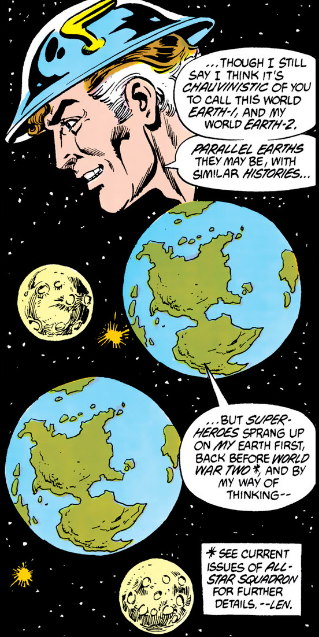
…and it was just off to the races. But I think it was a problem of public perception and confusion, as per that Action #484, that egged along a desire to streamline and get rid of potentially confusing elements such as “two Wonder Women” and the like. (Oh, and that specific letter published in New Teen Titans that inspired Marv Wolfman, but that’s a whole ‘nother thing.)
Or as you say:
“The ONE thing I kind of liked about the consolidated world was that it did make it easier to team up or make groups like the Giffen JL. But the constant retelling of pre-Crisis stories (especially in the Superman titles) to basically reintroduce elements was tiring.”
It did spare DC having to jump through hoops (or, you know, run a panel like the one above) in order to have the original Captain Marvel on a team with Guy Gardner without having to explain that he has to commute from Earth-S via the Rock of Eternity so he can help the Justice League fight the Gray Man. (No, not that Gray Man.)
The problem DC ran into with this sudden overhauling of their multiverse into one universe is that the readership from one era carried over into a new era. It wasn’t like the gap between the Golden Age and the Silver Age, where DC could introduce a new version of Hawkman as a space cop, and a new version of Green Lantern as…er, a space cop, and there was enough readership turnover in the meantime that they didn’t have a bunch of fans writing in demanding this new Hawkman and GL be reconciled with the previous versions of the characters. I mean, I’m sure some did, but a lot of those eight year old kids who rode out the end of the initial Golden Age superhero era probably didn’t come back at 16, pick up that issue of Showcase and suddenly go on a tear on 1940s Twitter with #notmyflash.
Or maybe they did. I don’t know, I wasn’t there, but I suspect that publishing gap gave DC enough of a clean break that they could essentially start over again with a minimum of reader confusion. The Crisis on Infinite Earths rejiggering had no such gap, and the folks reading before were told “forget everything you knew” and were along for the ride as DC tried to figure out in real time how this new fictional set-up was going to work.
The original plan of just restarting everything from scratch at the conclusion of Crisis might have been sufficient enough of a firebreak between What Came Before and What We’ve Got Now (well, Then-Now, you know what I mean), since DC putting everything on hold for five or six years obviously isn’t practical. ‘Course, they chickened out on that, and now (real now, not Then-Now) we’ve got what we’ve got. They did eventually sort of try that out with their New 52 publishing initiative, but even, like, Green Lantern comics just kinda carried on as usual, so the break wasn’t as clean as it should have been.
Crisis on Infinite Earths (like New 52 later) did serve its purpose, which was “get more eyeballs on DC Comics,” at least for a while. People have said in my comments and elsewhere that Crisis goosed them into trying out DC’s other titles, which is the ultimate goal of any superhero universe crossover event, even more so than DC’s annual attempts at redefining what “DC Universe” actually means.
Next time: more question response or that parallel Earth post I’m gathering panels for. We’ll see!
Gonna start responding to some of your Multiverse Talk comments here, though I do have more multiverse content to come. Just thought I’d get a head start:
Daniel sez
“DC would have been better served if their in-universe history had played out like it did in Darwyn Cooke’s DC: The New Frontier, with it all taking place on the same Earth, and with Superman, Batman, and Wonder Woman bridging the gap between the JSA generation and the JLA generation.”
The big reason I like this idea is that it reflects what happened in the real world…DC’s 1940s heroes all went away, only starting to come back, what, five years later with the debut of Silver Age Flash. During that interim period Superman, Batman, and Wonder Woman continued to be published, presumably as they were the biggest money-makers, perhaps in sales but certainly in licensing.
The one downside, perhaps, at least as far as the publisher’s desire to maintain an I’s status quo, is that this would age the Supes/Bats/WW trinity. Okay, maybe not Wonder Woman, who’s generally portrayed as immortal. And I know some would argue Superman is also immortal, but I think, in my wholly unverified opinion, that we’ve had enough “Old Supes” stories over the years that the idea of that character aging is probably generally accepted.
Regardless, having S/B/WW around for the Golden Age of Heroes, then a brief intermission, then being the Older Still Active Heroes once the Silver Agers start showing up, that would put their ages at…well, I guess it depends on 1) how long the Golden Age was in-story; and 2) how long the break between generations was. In the real world, Superman first appeared in 1938, and, let’s see, All-Star Comics #57 in late 1950 was the end of the Justice Society’s original run. The Silver Age launched with the arrival of the new Flash in Showcase #4. So with these examples, we have Supes active for 12 years until DC’s Golden Age ended, he hung around for 6 years, and then boom, the Silver Age.
Thus at the beginning of the Silver Age, Superman is however old he was in the original comics, let’s say 30, add 16 on top of that, so he’s about 46 as the Silver Age begins. NOW, for in-story purposes none of that matters, as it could be established the Golden Aqe was a whole year long, the break was a year long, and thus Superman’s still in his early 30s when the new cast of Silver Agers move in.
I mean, that’s all just playing with numbers trying to sort out that particular hypothetical circumstance. But then Daniel also sez
“I think the biggest mistake that DC made was to narratively tie the Earth-Two characters to a fixed point in history (e.g., World War II). Just as the Earth-One characters perpetually took place in “the present,” there’s no reason that the Earth-Two characters couldn’t have perpetually taken place ’20 years ago’ without being tied to a specific historical period.”
The two solutions would be, as you said, making their prime active years “twenty years ago,” which will still feel weird to us old fanboys (the JSA active circa 2002? egads) but that’s the only way to really do it, I guess. Though they could “Captain America”-it and establish they were “stuck in limbo staving off Ragnarok” or something. The other solution is to put them on a parallel Earth where the heroes did debut during WWII, and journeys to that Earth either bring you to that wartime era, or, if you want older heroes, to, like, that’s Earth’s “present” which would be set in the 1970s or thereabouts. That avoids messing with “main Earth” and its sliding-scale “our heroes first showed up 5/10/20 years ago” universe.
A long time ago on this site, somewhere, where I can’t find it now, I noted one (only one?) of the weird things about the Smallville TV show is how what is essentially the Superboy part of the Superman story is taking place “now.” We, The Comic Book Fans, are used to Superboy stories set “15 years before now,” and sometimes reflecting the world as it existed (like “Superboy’s Mission for President Kennedy!” or, in New Adventures of Superboy, seeing the occasional hippie). Moving the Adventures of Clark Kent as a Really Tall Boy in Smallville to current day just seems weird to those of us familiar with the source material, in the same way moving the JSA’s origins away from its WWII era would feel equally odd.
Again, just for the folks used to it. If DC insists on giving the JSA its own “20-30 years ago” sliding timescale, we old folks just have to get used to it, and assuming DC remains consistent with its application (and that’s a big assumption) it just becomes the norm for newer readers regardless of how many angry letters 50+ year JSA fans write to the Comic Buyers’ Guide, despite it being defunct.
In response to your many emails, comments, Tweets, phone calls, faxes, certified letters, numbers stations broadcasts, and telegrams, I will discuss the upcoming 30th Anniversary “Death of Superman” comic, probably next week in my usual timely “ripped from yesterday’s headlines” fashion.
But today, we’re back to the Marvel mutliverse! When we last met, I was talking about two specific questions that had some to mind regarding it. In that post I was curious as to the origins of the designation “Earth-616” for Marvel’s “main” Earth. That was something I’d been wondering about for a while.
The next question is one that popped into my head relatively recently, which is “does the Marvel Multiverse have a specific Earth for the heroes of DC Comics?”
The answer it seems is “no” — it looks like the idea is that Marvel’s multiverse and DC’s multiverse are two separate multiverses, comprising part of a larger Omniverse, if you will. I mean, it’s something like that…a little handwaving to create a mutually-beneficial metafictional construct that ensures one company isn’t a specific subset of another company’s milieu. That said, as per DC’s Multiversity, there are a couple of Earths with characters obviously based on Marvel properties. And Marvel of course has their Justice League analogues the Squadron Supreme, but each of the main Marvel and DC Universes remain separate from each other’s multiverses.
Sort of.
I was perusing the Wikipedia list of Marvel’s multiverses and there is an Earth-7642 where both Marvel and DC’s characters live and can crossover with each other. So Superman/Spider-Man, Batman/Hulk, all those intercompany events where, like, Superman’s all “ah yes, I’ve heard of this Spider-Man fellow out in New York” but the two characters never got around to meeting before…that’s this Earth.
This is presumably separate from those between-company events where characters specifically travel between universes in order to meet, like in Superman/Fantastic Four. I’m assuming in this case it’s presumed that Superman is traveling from the prime DC Universe to the prime Marvel Universe. Unless each universe has an Earth with their company’s characters that spefically cross over into the other company’s universe, versus the regular “prime” Earths doing so, and does anyone else here have a nosebleed or is it just me?
I probably should mention Earth-9602, Marvel’s designation for the alternate universe created when the Marvel and DC universe were merged together during the Marvel Vs. DC mini-series. That’s the Amalgam Universe, effendi, where Iron Lantern and Spider-Boy hang out, probably never to be seen again.
Now on the other side of the aisle, Doomsday Clock, which all of you out there read and enjoyed, posits a future intercompany event between Marvel and DC. The couple of caption boxes describe the perfectly named “Secret Crisis,” mentioning the non-copyrightable name of Thor and references a “green behemoth,” presumably the Hulk and not, I don’t know, the Impossible Man maybe. I’m assuming this is supposed to represent another breach between the main Marvel and DC multiverses, though it could be a specific Marvel Earth within DC’s own multiverse…it’s vague enough. It might even be that Marvel-inspired Earth from Multiversity. Who knows.
I’m making this more complicated than it already is, and I’m sure you’re as sick of the world “multiverse” and I am of typing it. And look, I know I didn’t even mention Access, the character created specifically to travel between Marvel and DC. Or that Earth-7642, Crossover Earth, also has other characters that crossed over with Marvel, like the Archie characters.
So to reiterate: from all appearances the Marvel and DC Multiverses are each their own thing, and do not exist within each other’s multiversal array. Each universe contains analogues of the other’s characters, however Marvel has an Earth where all characters of all the companies coexist. But some stories explicitly use a multiversal crossing of some sort to allow Marvel and DC to team up.
I think I’ve got that right. If I got any of that wrong, please send all corrections to pal Ian.
Before Marvel started cataloging all these separate Earths (more of which I’d like to talk about…I’ve got questions about the Earth where the Marvel LEGO video games take place), the Watcher in What If? #1 wasn’t even sure where that first Superman/Spider-Man hoohar took place:
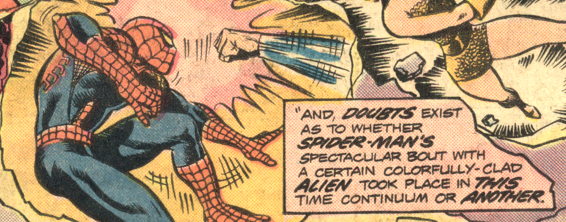
…though to be fair, he didn’t say he didn’t know, just that doubts exist as to what universe that meeting belonged. It’d be just like Uatu to not tell us. …Actually, it wouldn’t be, this dude blabbed a lot in this series.
Anyway, thanks to Twitter pal WormDrive PRO, we have these samples of letter column concern in regards to that first Superman/Spider-Man team-up from Amazing Spider-Man #158 and #159 (1976):
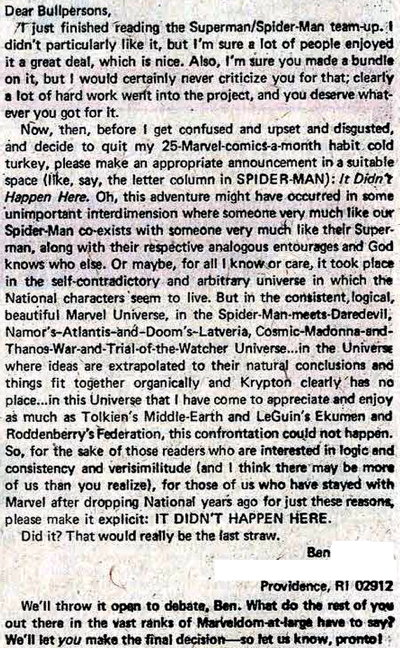
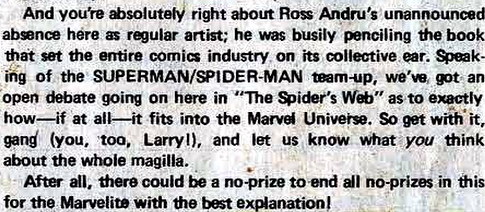
I don’t know what the ultimate resolution or response was to that editorial “what do YOU think?” but boy, that letter writer sure was mad about the guy logically bitten by a radioactive spider and thus given spider powers meeting an alien arbitrarily sent from an exploding planet. I suppose it’s a tribute to Marvel’s construction of a shared universe that some readers would get so upset about the intrusion of elements that would seem to disrupt it. I mean, it’s only just a comic book, they should really just relax…the very idea that maybe the two companies just wanted to have some fun and see what happened when they paired their heroes (and also make a ton of cash in the process) was a distant second to the threat that the Marvel Universe might be “diluted” by this most unnatural contact.
But the question was eventually answered. It’s Earth-7642. There you go, long ago letter writer, that’s the solution. See, wasn’t that easy?
So it turns out you folks had a lot to say about their funnybook multiversal experiences. In true Progressive Ruin fashion, where YOU Are The Content™, I will do a post covering your comments, but in the meantime, lemme type a few words about Marvel’s various universes.
When I got to thinking about what my first experience was with multiverses in comics, my mind immediately gravitated towards DC. It ’twas DC what rode that parallel universe horse to exhaustion, making it a huge part of their fictional milieu. Not that Marvel didn’t fool around with parallel Earths an’ such as well (probably most notably earlier on with the Squadron Supreme. But as I reflected on this, it likely turns out my very first encounter with multiverses in comics was that very first issue of What If?. I wrote about that comic at length a few years back, so I’ll just say here that the Watcher giving a everyone a crash course on alternate realities in that book pinned down the concept for me at age 7, probably long before I was wondering why there were two Supermen in this DC comic, and why does one of them have gray temples?
There were a couple reasons why Marvel’s multiverse had come to mind recently. I mean, I’m sure in general it’s just the overall Disney-generated zeitgeist infecting pop culture at the moment, courtesy their movie/TV vectors. But I started wondering about two things.
First was “why is Marvel’s ‘main Earth’ called Earth-616?” I mean, like, why that specific number? This is something I’ve kind of wondered about since first coming across that particular designation in a 1983 Captain Britain story by Alan Moore and Alan Davis. Or rather, seeing some panel reprinted somewhere, since a U.S. reprinting wouldn’t happen ’til the mid-1990s. Here it is from the U.K. Marvel comics magazine Daredevils #7:
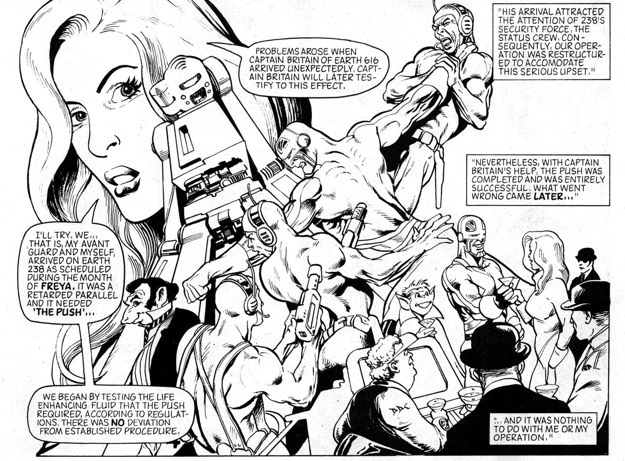
I was of two minds. One, that “616” was a known alternate for “666,” the most evil phone number prefix. I thought maybe “Alan Moore was making some kind of sly comment on the Marvel U.” by calling it that. My other idea was that it was simply a larger number given to Main Marvel Comics Earth, indicating it’s just an Earth, not the Earth, in contrast to DC’s “Earth One,” “Earth Two” etc.
I’ve actually wondered about that for a while, and finally sitting down to do some extensive research (i.e. looking it up on Wikipedia) it turns out…both are possibilities? Frankly, I feel like Alan Davis’s explanation that the previous writer on the feature came up with the term as, I had guessed, an implied criticism of Marvel’s superhero shenanigans, carries a little more weight. I don’t know if that writer, David Thorpe, ever used it directly in his stories or were just background he created for the series that were passed on when he left the book. Anyway, this archive of the old Marvel blog goes into detail, direct from Davis’s mouth.
Now, the second question about Marvel’s multiverse that I’d been pondering…will have to wait for Friday! Thanks for reading pals…and if you have more info or opinions about the above, please feel free to leave a comment. I always like hearing from you all.
Special thanks to Bully, the Little Stuffed Bull of Earth-Prime, for his help with this post. Also thanks to…somebody, maybe Neil Gaiman I think, for the title of this post, from whom I shamelessly stole it.
So I was thinking about multiverses and parallel Earths, as one is wont to do, specifically in the context of comical books. Amongst this reflection one of the topics was “what was the first multiverse story I ever read in comics?” Given I was primarily a DC kid, and given that company was the one that traded most in this sort of thing, I’m sure it was some DC comic from the late ’70s/early ’80s.
Just to keep you from being in suspense, the answer is “I don’t know,” as DC’s set-up of “Earth-One” (where DC’s main line of heroes lived), “Earth-Two” (where the Golden Age characters lived, and for the most part were older than our regular heroes), “Earth-Three” (Oops, All Villains) and so on were pretty ingrained in me from the start. Maybe it was introduced to me in the digest reprints, maybe a Flash team-up with the Golden Age Flash. I even remember Bob Rozakis in one of his Answer Man columns running down the list of DC’s various Earths (which is where I learned that “Earth B is where all the stories that don’t make sense take place!” — a veiled reference to Robert Kanigher and/or Bob Haney, apparently. And no, that exact column isn’t at the link, but plenty of good examples of what Bob was up to there).
I know my favorite parallel Earth story is this one, a Justice League of Earth One/Justice Society Earth Two team-up — an annual tradition, as least for a while. That Gerry Conway/George Pérez extravaganza remains in my head the quintessential multiverse story, and is just plain Good Comics.
Anyway, parallel universes were just part of the fabric of DC’s superhero comics, and while it could lead to some confusion for the uninitiated, such as when apparently DC got some real world attention when Superman married Lois Lane in Action #484…the Earth Two Superman that is! Some folks were like “um, so not the real Superman?” Anyway, it was sort of deliberately misleading even to the initiated, as you may be able to tell from this cover:
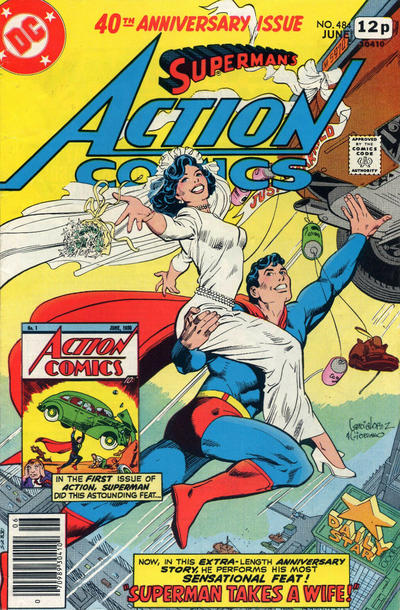
…where Superman’s chest emblem is deliberately obscured. As all true Earth Two fans know, the Superman of that Earth had a slightly different design. You can see the difference in this pic from Crisis on Infinite Earths, with Two on the left and One on the right:
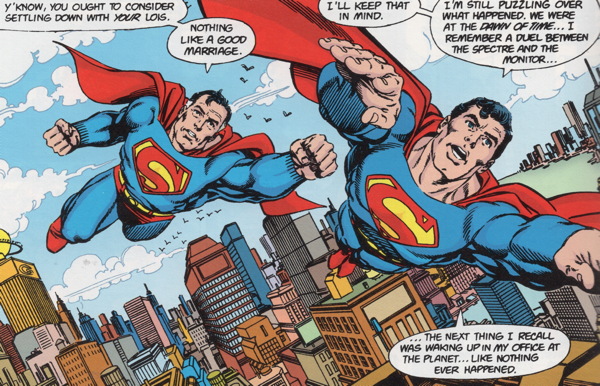
And I’m pretty sure the fact that it was Earth Two Superman tying the knot was not made explicit, as per this news blurb from The Comic Reader #150 (February 1978):
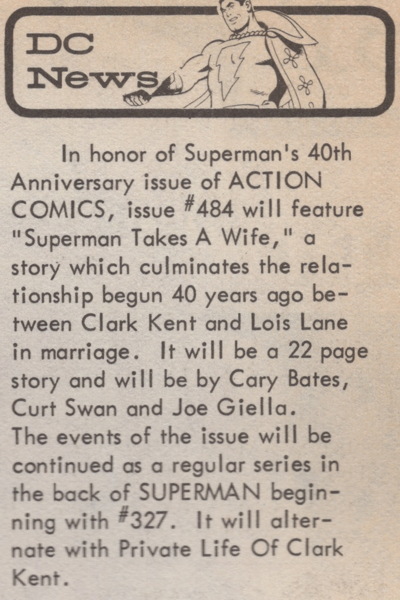
I mean, sure, you can maybe infer it after the fact, with all the “40 year relationship” talk, as, well, the Superman of Earth One clearly hasn’t been wooing Lois for 40 years, they must be talking about that Superman on Earth Two who’s been around since Dubbya Dubbya Too. But honestly, even without all this, most people picking up the book were probably “yeah, right, sure, Superman’s getting married, I’ll believe that when I see it” and then, well, they saw it. Surprise! Just not the Superman they may have been expecting.
That was bit of an aside, I realize. Been meaning to bring that up somewhere for years. So please excuse the lack of transition to the next bit.
When Crisis on Infinite Earths hit a few years later, well…okay. I think I’ve said it here before, I’ve definitely gone on about it on Twitter, but a major element of COIE was experiencing the Big, Permanent Never-to-Be-Reversed Changes in real time. Opening up issue #1 and having it lead off with the destruction of Earth Three and the character thereon was quite the shock. The art’s impeccable, the story is, um, well…the art’s impeccable, and it was an exciting read at the time as you didn’t know what drastic thing was going to happen next to the DCU. And worlds lived, worlds died, and nothing remained the same…
…and then DC spent decades trying to make everything the same as it was, or at least a close approximation, as event after event was released trying to patch Crisis with more Crises, more events, more restorations of parallel Earths and multiverses, even until right this very moment. And none of it feels as simple and as, honestly, organic as when we had our annual JLA/JSA crossovers, or when the Golden Age Green Lantern would team up with our Earth One Green Lantern, and so on. Sure, there was the occasional roadbump, like that Action #484, but eh, we dealt with it.
I’m trying and likely failing to not sound like Cranky Old Fan Wants Things Like They Were, because…look, I like new comics just fine. I’m even enjoying Dark Crisis (now Dark Crisis on Infinite Earths, as of issue #4). And I’ve liked a lot of the weird multiverse stuff we’ve been getting recently. But I keep thinking “maybe if COIE didn’t happen, a whole lot of creative energy could’ve been used for something other than trying to fix it.” Hypocritically, I’ve read every one of these attempts and mostly enjoyed them for their strange metatextual efforts. Yes, even Doomsday Clock.
But I think DC has given up their once-strong multiverse advantage to Marvel, who’s grabbed the concept with both hands and wrestled it to the ground, making the idea their own. Should the Flashpoint movie ever actually come out, it’s gonna look like an also-ran with its multiversal storytelling after Marvel’s been riding that wave through multiple movies and TV shows. And yes, the Flash TV show covered that ground as well, but I still think it’s really Marvel’s ball now.
More on Marvel next time. Thanks for enduring this post, pals…had a lot of semi-related thoughts to get out of my head, and it turned out I have a blog so here they went. See you Wednesday.
Newer Entries »







































